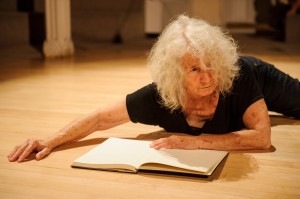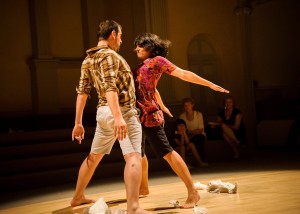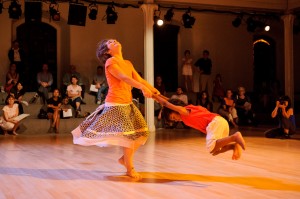
by Tyrus Miller
40 Dancers Do 40 Dances for the Dancers
Conceived and directed by Clarinda Mac Low
Based on the text by Jackson Mac Low, The Pronouns: A Collection of Forty Dances for the Dancers (3 February-22 March 1964)
Platform 2012: Judson Now, Danspace Project, St. Mark’s Church, New York
13-15 September 2012
In 1961, poet Jackson Mac Low composed Nuclei for Simone Morris (later retitled Nuclei for Simone Forti), a dance piece that derived a set of actions by selecting verbs from a word list according to a set procedure. Mac Low’s Nuclei began from a poet’s reflection on the complex interrelations of different media of meaning-making—language, writing, sound, movement—and what kinds of creative “translations” can occur when one seeks to cross from one sign-system to the other and back. True to their name, the Nuclei not only constructed a framework of instructions for developing different instantiations of that one work; they also generated a whole new set of texts, The Pronouns,[1] utilizing the same underlying materials (the action card pack) and analogous, though further elaborated procedures for deriving texts and performances from them. The number of Mac Low’s texts, forty, related to a list of English-language pronouns, whereby each of the texts is organized around a single pronoun, ranging from the obvious “I,” “you,” and “we,” to more complex ones such as “who,” “nobody,” “either,” and “whichever.” These combine with other words to make texts with a somewhat Gertrude Stein-like flavor, combining phrases such as “Someone then says things as a worm would, / but also as one keeping sheep or seeing an offer, / while willing themselves to be dead or coming to see something narrow” (17th Dance). Among Mac Low’s interest in using the pronouns in this way was to explore how certain often-subliminal features of language imply and occasion different sorts of social interaction, segmentation, and identification.
The category of pronouns occupies a special place in language, since their meaning is determined solely by their function of marking the changing positions in a discourse or conversation, rather than by reference to any fixed object or concept. Linguists even refer to pronouns by the special name of “shifters,” because a word like “I” or “you” shifts from position to position as different speakers occupy the place of addressing others or being addressed. The old Abbott and Costello routine about “Who’s on first?” imagines a comic world in which, rather than shifting in this way, pronouns function as names, rigidly designating the persons to which they refer: “No, who’s on second. . . “ In contrast to these comedians, Mac Low’s poetry even further radicalizes the shifting function of pronouns, asking us to understand pronouns as the paradigm of language as such, which for him was a vocabulary full of “empty words” (John Cage’s term) that can be occupied in an open-ended, indeterminate number of ways. For Mac Low, language offered models, mobile spaces, and temporary positions for people to come together and interact in structured, but freely chosen ways—and his poetic and performance works seek to heighten our awareness that language “has room” for us to be together in many different sorts of creative, emotionally rich, non-coercive encounters.[2]

In reviving and making new The Pronouns in 2012, Clarinda Mac Low demonstrates a deep understanding of her father’s artistic and political intentions, while lending the performances and project as a whole her own original, self-reflexive spin. On this occasion—the first major presentation of the work since the 1980s—I was able to attend two of the three performances, the second and third night, as well as speak with Clarinda Mac Low (hereafter referred to as CML) about the production and with one of the performers, dancer Lise Brenner. In her program notes, CML characterizes her work on this presentation of The Pronouns as an anthropological investigation into the network of relations existing in the New York dance community, as well as an exploration of how an artistic work / performance event such as the 2012 Pronouns may inflect the bonds of that community and help extend them in new directions. She writes, “The resulting piece is not so much an esthetic product as an esthetic by-product of a social situation, where the provisional community formed by a shared project is as important as the performance itself” (CML, “Director’s Note”).
The cast was selected by a combination of existing connections and friendships and the various contingencies of who was available, whose name was raised in the course of working on the project, and other factors of what we might call, after the surrealists, the “objective chance” of living in New York and working among its shifting, overlapping artistic communities. CML’s selection brought together a diverse group of performers, ranging from senior dancers such as Simone Forti (who performed a version of Nuclei each night) to various children, and from professional dancers of different training and artistic orientation to musicians, writers, and other artists. At the outset, each of the participants were given a copy of The Pronouns and asked to select one of the dances for which they had a special interest, resonance, or affinity. Dancers who chose the same dance poem were paired or otherwise combined, while all forty dances were eventually distributed among the group. In turn, an algorithm was applied to determine the distribution of the dances among the three nights (while again, the exigencies of everyday life—availability of the dancers, child care, etc.—qualified the order somewhat away from the pure mathematics of a formula).

Each dancer was given considerable freedom to interpret the piece as they saw fit, but also confronted with the daunting task of realizing by some means or another every line / instruction in Mac Low’s text and rigorously observing Mac Low’s syntactical cues of sequence, simultaneity, and consequence (thus, attending to words such as “then,” “afterwards,” “at the same time,” and so on). One of the most notable features of the performances, and something that I became even more aware of over two nights, was the extraordinary range of interpretative means that CML’s performers employed to meet this challenge. At one extreme, there was pure verbal recitation of the poem, as in the performance of the 34th Dance on the third night: a voice speaking the lines in the dark. At the other, there were almost purely dance-gestural interpretations, largely free of any evident mimetic content, however much these might have been part of the dancer’s original thinking about the various lines in the piece. (For example, as she explained it to me in conversation, in developing her performance of Dance 15, Lise Brenner obliquely used the music’s introduction of the word “saddle” to capture Mac Low’s line “gets leather by language,” while other parts of her performance were made up of relatively improvised site-specific interactions with the St. Mark’s space.) In between these extremes of almost purely verbal and almost purely non-verbal interpretations, there were numerous shades of language use and vocalization: the poem’s lines being chanted to a drone (third night, the 26th Dance), the poem’s lines read alternately by different performers, as if part of a dramatic dialogue (third night, 24th Dance), dancers reciting certain lines while dancing (numerous dances), performers making vocalizations that enacted the poem’s instructions while not directly reciting them (e.g. making interrogatory sounds to interpret the instruction of “questioning”). A similar multiplicity of approaches marked the movement idioms of the performers: seemingly abstract dance movements, dramatization of lines, mimetic hand-gestures, enactment of everyday movements, drumming and other instrumental performance, interactions of live performers and the image of distant performers projected from Skype.
This plurality of interpretive approaches created a lively variety of performance types across the different pieces and across the three evenings of performance. It also, however, related in interesting ways to a hidden, internal “rhyme” structure between the pieces, which contributed to the underlying cohesion of the three-night project as a whole, while never imposing an external design. To a very careful viewer or to a viewer (like myself) who brings a closer awareness of Mac Low’s text to the performance, some of the means of this internal structure may become visible from time to time before submerging again in the flow of the individual pieces. Because Mac Low utilized procedural means to generate his texts, several actions appear multiple times across the forty dances, actions such as “reacting to orange hair,” “fingering a door,” or “doing something under the conditions of competition.” Yet textual repetitions of this sort—which, as noted, connote a relation to the work of Gertrude Stein for readers of Mac Low’s book—may remain nearly indiscernible for most of the audience, who are viewing the textual details only through the multi-semiotic translations of performance, which disseminates and greatly expands the compact terseness of Mac Low’s poems. To the extent that one is aware of these verbal “repetitions,” for instance by referring the performance to the instruction-texts, one can understand how Jackson Mac Low offers a new pendant to Stein’s important argument that her “repetitions” were not repetitive at all, but creative. Repetition, Stein and Mac Low both suggest, comes not from iteration, but rather from the failure to reinvent new ways of giving value to words, relations, and forms. In this regard, too, CML has avoided any antiquarian or merely historical interest in reviving this classic dance-piece of the 1960s Greenwich Village avant-garde. Her 2012 Forty Dancers is genuinely a creative iteration, not at all a mere repetition of a past event.
Notes
[1] The texts and related essays are available in Jackson Mac Low, The Pronouns: A Collection of Forty Dances for the Dancers (Station Hill Press, 1979).
[2] I have discussed this dimension of Mac Low’s work (including The Pronouns) more extensively in my essay “Situation and Event: The Destinations of Sense,” in Ritual and Event: Interdisciplinary Perspectives, ed. Mark Franko (Routledge, 2007), 75-90; and in several chapters devoted to Mac Low in my book Singular Examples: Artistic Politics and the Neo-Avant-Garde (Northwestern UP, 2009).